

? | Home page | Tutorial | Recording




Before anything else, we need to prepare the recording session. We are not going to look for a melody, nor improvise or rehearse... we are going to properly record a song that we have already written. To avoid doing the same things over again each time I wish to record a song, I prepared a blank template which contains all the tracks and buses I need. I may naturally add or delete some elements if the template is not appropriate for the current project.
What does my template look like?
Track-wise:
- Rhythm guitar tracks (from 2 to 8 depending on the project)
- Solo guitar tracks (usually 2 tracks to make the sound thicker)
- Two bass tracks (one with the direct raw sound, and one with an amp simulation)
- Lead vocal tracks (usually one or two tracks, depends if I record it twice or not)
- Background vocals tracks (if the project demands it)
- Keyboard tracks (same thing, the number of virtual instruments will depend on the project, can be none, can be 5 or 6...)
Then we have drum tracks. There is one track per drum element. They are automatically created when I insert my virtual drum plugin:
- Kick drum
- Snare drum
- Low tom
- Medium tom
- High tom
- Hi-hat
- Crash cymbal
- Ride cymbal
- Splash cymbal
- Overhead microphone
- Room Ambiance microphone
- Piezzo microphone
- One MIDI track on which the drum score will be placed.
Bus-wise, I have one group for the guitars, one for the bass, one for the vocals, one for the drums, each of them is redirected towards the Master bus, which goes out throuh my studio monitors. It looks like this:

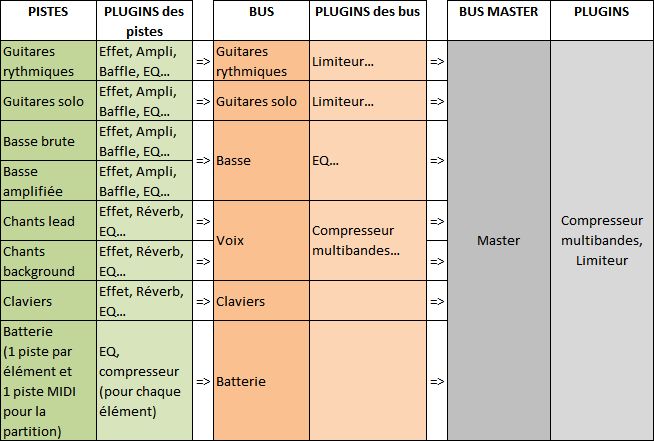





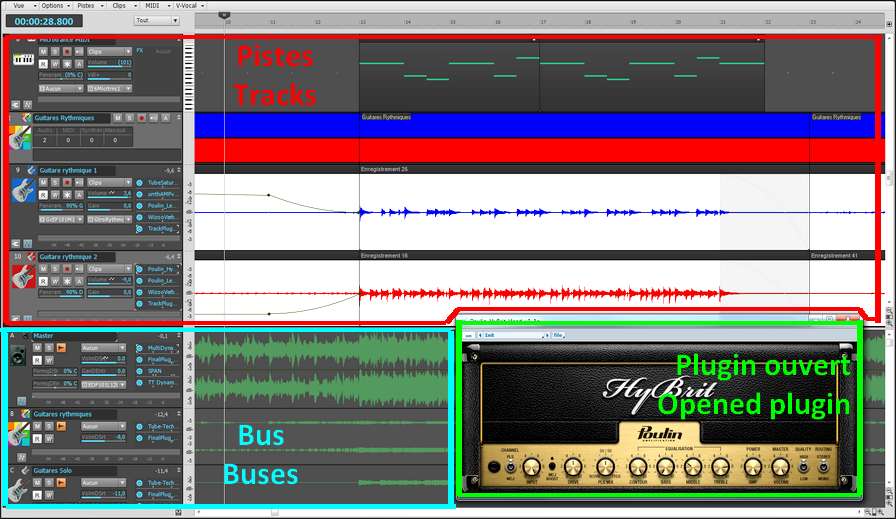


Recording an acoustic real drum kit is far from being easy, even for professional sound engineers. It a time-consuming process, it's frequent to spend several hours placing the microphones around the drum elements before you can actually record. But we are in a home studio, and we will have to deal with a software drum kit, based on midi files...
First of all, why start with the drums? The answer is simple, we will use drums as a metronome. The drums sound will guide us and help us follow the tempo. This will allow for an even recording and the song will not speed up or slow down unintentionally. Of course, variations can be interesting and bring some life to an otherwise mechanical tempo, but let's consider that a studio session seeks recording perfection, even though it's only a home studio.
I usually have no idea what my final drum track will sound like. Actually, I only adjust it when the rest of the song is finished. But I still need its metronome function to record all other instruments. Thus, I create a drum track which repeats itself over and over again, and I try to have this loop match what I am about to play (no punk rhythm to record a ballad). For instance, I'll use one of these patterns:
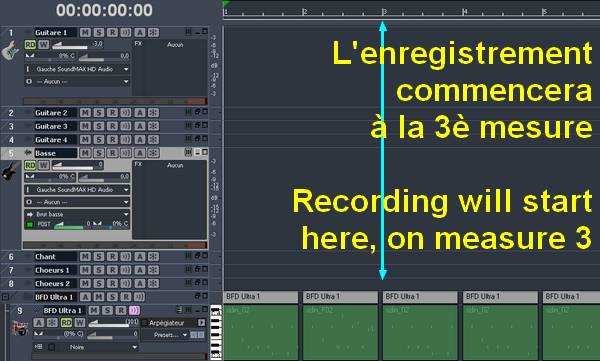

Let's not forget we are recording in a home studio, in an appartment and it is simply impossible to play with a good old 100-watt tube amplifier, without the neigbors calling the police. So we are going to have to record the guitars and the bass directly through the audio interface. No real amplifier, no microphones involved. The latter solution would be preferable, but on of the benefits of direct recording, coupled with amplifier simulators, is that you can always edit the sound later, without having to re-record. Just change the settings and you're done.
So now... bass or guitars first? There isn't one clear answer. Bass and drums are the foundation, the rhythm base of a song and everything else should rely on them. But other factors could also be taken into consideration: for instance, the person recording may be more comfortable with a guitar than a bass, and will rather play guitar first. Or maybe the song has a very important bass riff that compels you to record it first. In any case, you are the one who can decide. If you are uncertain, then the drum / bass duo is a safe bet. If this is in place, then the rest can easily be added.
Guitar or bass, the recording process will be the same. Plug your guitar into the pre-amp, the pre-amp is connected to the audio interface (or plug your guitar directly into the audio interface if using the interface's pre-amp), and set the recording level. This is very important! Before recording anything, check that you are not going to go beyond the maximum level (0 dB, zero decibel). In a home studio, you won't have a sound engineer besides you to make adjustments on the fly, while you are playing. You are the one to take precautions. How can you do that? Simple: try and adjust, it doesn't take long and will prevent you from making a perfect take, then realize the levels were too low or too high, forcing you to do it all over again.
Have a try: for a rhythm guitar for example, play the loudest parts and set the preamp and audio interface volume levels in such way that when you play the loudest, the recording level doesn't go beyond -6 dB. The absolute maximum that you should not reach or go beyond is zero dB. If you play in your try the same way you play during the actual recording, then you can be certain the recording level will be correct. If your average level is between -9 db and -6 dB, then your level is sufficient and you have a margin of error before clipping.
Clipping is the term used to indicate that you reach or go beyond 0 dB. Clipping is your enemy :-)
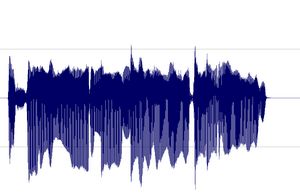
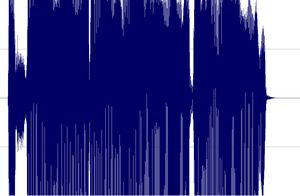
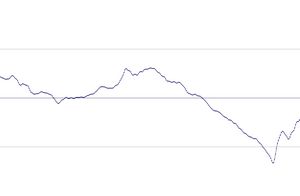
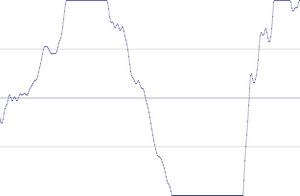

I prefer to record them last but there are no rules. If you prefer to record them first, then do so.
To record vocals, make sure the place is quiet, shut the door, tell the people who live with you to be quiet, and do not record while your neighbor is drilling holes through his kitchen walls! Also, turn off your monitors and use a headset instead to avoid recording the playback with your microphone.
Condenser or dynamic microphones?
Dynamic microphones are solid, they don' need a power source, they can take heavy acoustic pressure (like a kick drum or a saxophone) and they are not too expensive. They are also less sensitive to surrounding noises than condenser microphones. The cons are they lack clarity in the high range, which renders takes less clear and defined than with condenser microphones. They can be used with Jack or XLR plugs.
Condenser microphones are much more responsive and accurate. Their high sensitivity is double-edged, because they will capture any noise when recording. The fans of your PC are noisy? Chances are this noise will be recorded. Sound comes out of your headset? It will be recorded by your condenser microphone. Children are loudly playing outside? You might get that too. However, some condenser microphones are called "cardioid", or "hyper cardioid", and they only record what comes from a specific direction, ignoring (more or less) other sound sources from other directions. On the contrary, omnidirectional microphones record what comes from anywhere. Not ideal for a home studio. Condenser microphones are also more fragile (don't knock them) and must be powered through a "phantom power", whose standard is 48 volts. This kind of power is either present on your audio interface and can be turned on and off with a button, or it will require the use of an external phantom power source that you will then connect to your audio interface. You have to use 3-pin XLR plugs that carry the phantom power current. Finally, condenser microphones are usually rather expensive, some of them cost several thousand euros (or dollars, or pounds), but only professional studios or rich amateurs can afford those. On the plus side, the sound you get with a condenser microphone will have the best quality.
Be cautious though, a good dynamic microphone is worth better than a bad condenser microphone. No big secret here, for microphones like for anything else, very low prices are rarely synonymous with good quality.
A few known and renowned microphone brands: AKG, Milab, Neumann, Rode, Sennheiser, Shure...
Some pieces of advice: buy a microphone stand and a pop filter (you can also make one yourself with wire and a piece of tights from your wife / girlfriend / mother / daughter / neighbor). The stand will prevent you from manually holding your microphone and thus produce handling noises. As for the pop filter, it prevents the air to hit the microphone and produce unwanted blowing sounds when you pronounce some letters such as "p" or "b".
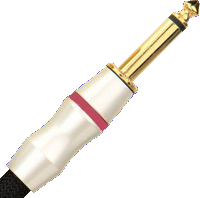
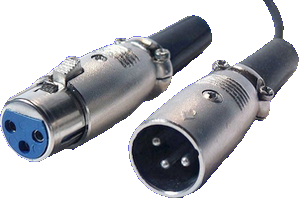
Jack plug (left) and XLR (right)
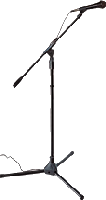


No need to go on and on forever, recording is rather easy. As long as you pay attention to your recording levels and take care over your takes, you should get a satisfying result, good enough to finalize the song

Messages page # 1 2 3 4 5 6 7 8 9 10 11 12 13 14 15 16 17 18 19 20 21 22 23 24 25 26 27 28 29 30 31 32 33 34 35

Kain
le 04/12/2016 à 05h00
Hello ^^
Jette une oreille aux productions de Positive Grid. C'est payant, certes (mais souvent en promo), mais surtout... ça vaut le détour !
* * * * * * * * * * * * * * * *
<em>
Merci Kain, en effet les avis sur les simulations Bias de Positive Grid sont en général élogieux, mais je ne les ai jamais essayées, et je ne parle que des choses j'ai testées moi-même.
Pour ceux qui seraient curieux, les tests ne manquent pas sur le Net, n'hésitez pas à aller vous rendre compte par vous-mêmes !
Grebz</em>

CamilleDeby
le 06/11/2016 à 16h43
Salut !
J'ai un problème qui vous semblera peut être totalement idiot si vous êtes connaisseur mais j'ai installé la version 5 de Traktion et j'aimerais y ajouter des plug-ins mais je ne trouve pas le dossier "vst". Est-ce à moi de le créer ? Merci 1000 fois !
* * * * * * * * * * * * * * * *
<em>
Bonjour Camille,
Merci de consulter mon site !
Je ne connais pas Traktion malheureusement, mais j’ai consulté le manuel de Traktion 4 sur Internet (je n’ai pas trouvé celui de la version 5, mais je ne pense pas que la gestion des VST ait changé d’une version à l’autre), et voici ce que j’y ai trouvé :
Les paramètres concernant les plug-ins tiers (ceux qui ne sont pas fournis avec le logiciel) peuvent être gérés depuis le groupe Plug-Ins de la page des paramètres (« settings » en anglais, si le logiciel est en anglais).
On y voit la liste de tous les plugins installés et des informations les concernant.
Sous la liste se trouve un bouton « Scanning and Sorting… » (recherche et tri, le manuel que j’ai trouvé est en anglais) qui permet de dire à Traktion de rechercher de nouveaux plug-ins ou des plug-ins mis à jour. En cliquant sur ce bouton, on a un menu avec différentes options :
- Clear list : cette option supprime tous les plug-ins de la liste. Ils ne sont pas désinstallés, mais Traktion les ignore si cette option est sélectionnée.
- Remove selected plug-ins from list : idem que ci-dessus, mais l’option ne supprime que les plug-ins sélectionnés dans la liste.
- Show folder containing selected plug-ins : cela permet de savoir dans quel dossier sont installés les plug-ins de la liste
- Remove any plug-ins whose files no longer exist : permet à Traktion de détecter et supprimer de la liste les plug-ins qui ont été désinstallés, ou dont le dossier d’installation a été supprimé
- Sort alphabetically / by category / by manufacturer : permet de trier les plug-ins par ordre alphabétique / par catégorie / par fabricant
- Scan for new or updated Audio Unit plug-ins : uniquement pour Mac. Demande à Traktion de rechercher les plug-ins Audio Unit installés pour les ajouter à la liste.
- Scan for new or updated VST plug-ins : Sélectionner cette option pour afficher une boîte de dialogue dans laquelle vous pouvez ajouter des dossiers de recherche VST. Normalement, il suffit de cliquer sur le bouton « Scan » pour rechercher des plugins, mais cette option permet de spécifier des dossiers personnalisés dans lesquels vous avez mis des plugins VST.
Donc, d’après cette dernière option, cela veut dire que tu peux créer tes propres dossiers VST à l’endroit de ton choix sur ton disque dur (ou l’un de tes disques durs si tu en as plusieurs), et utiliser cette option pour indiquer à Traktion l’emplacement de ces dossiers.
En-dessous du bouton « Scanning and Sorting… », tu as également un bouton « Always check for new plug-ins at start-up », qui indique à Traktion de toujours chercher si de nouveaux plug-ins ont été installés depuis la dernière utilisation de Traktion lorsque tu lances le logiciel. Si cette option n’est pas activée, il faudra faire un scan manuel lorsque tu installes un nouveau plug-in.
Voilà, j’espère que ça répond à ta question. Je ne peux pas t’en dire plus, étant donné que je n’ai jamais utilisé Traktion, mais si tu ne trouves pas le dossier VST de base de Traktion, tu peux effectivement créer ton dossier perso et indiquer ensuite à Traktion où il se trouve grâce à l’option « Scan for new or updated VST plug-ins ».
Grebz
</em>

Thetit
le 19/09/2016 à 17h04
Salut, j'ai besoin de conseils car je me mets à la MAO. J'ai une carte son Presonus fp10 et cubase sx sous Windows Vista 32 bits.
J'ai téléchargé les simulateurs d'ampli guitare et basse pour pouvoir composer. J'ai installé les dll dans le dossier vst dans programfiles/steinberg/cubase/vst (un truc comme ça ;) ). Quand je démarre cubase je vois bien les simulateurs et quand j'ajoute un effet, ils apparaissent bien... mais je n'ai pas le son qui va avec, en fait j'entends toujours la guitare sec sans l’émulation (mais le signal est bien saturé pour un ampli hi gain par exemple mais niveau son, nada). J'ai essayé de chercher sur le net mais je ne trouve pas de solutions. J'imagine que ça doit être une histoire de config/paramètres mais franchement j'ai cherché presque partout mais rien n'y fait :( Je suis perdu. Peut-être auras-tu une idée.
Merci à toi et super ton site !!!

John
le 16/05/2016 à 22h17
Have you been able to emulate the sound of the Shadows, is there a preset for it?
* * * * * * * * * * * * * * * *
<em>Hey John,
I haven't tried, actually. From the videos I've found on YouTube, I can see they're using Vox amplifiers (unless it's just a background for the TV show they were playing in).
What song or sort of sound in particular are you thinking about?
Grebz</em>

Molotov
le 10/05/2016 à 07h25
How can I load an FX preset in Emissary?
